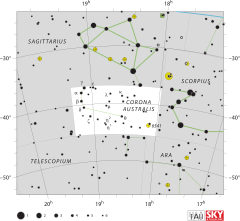
Back Meridiana Afrikaans Alfecca Meridiana AST Alpha Coronae Australis BS Alfa de la Corona Austral Catalan Alphekka Meridiana Czech Alpha Coronae Australis German Alfecca Meridiana Spanish فکه جنوبی Persian Alpha Coronae Australis French Alpha Coronae Australis ID
| Observation data Epoch J2000.0 Equinox J2000.0 (ICRS) | |
|---|---|
| Constellation | Corona Australis |
| Right ascension | 19h 09m 28.34097s[1] |
| Declination | –37° 54′ 16.1022″[1] |
| Apparent magnitude (V) | 4.102[2] |
| Characteristics | |
| Spectral type | A2V[3] |
| U−B color index | +0.06[4] |
| B−V color index | +0.04[4] |
| Astrometry | |
| Radial velocity (Rv) | −18.40±1.78[5] km/s |
| Proper motion (μ) | RA: 84.87[1] mas/yr Dec.: −95.99[1] mas/yr |
| Parallax (π) | 26.02 ± 0.25 mas[1] |
| Distance | 125 ± 1 ly (38.4 ± 0.4 pc) |
| Absolute magnitude (MV) | 1.11[6] |
| Details | |
| Mass | 2.57[7] M☉ |
| Radius | 2.21[3] R☉ |
| Luminosity | 31[8] L☉ |
| Surface gravity (log g) | 4.08[7] cgs |
| Temperature | 9,916±337[7] K |
| Rotational velocity (v sin i) | 195[9] km/s |
| Age | 254[2] Myr |
| Other designations | |
| Database references | |
| SIMBAD | data |
Alpha Coronae Australis or α Coronae Australis, officially named Meridiana (/məˌrɪdiˈænə/),[10] is the brightest star in the constellation of Corona Australis and is located about 125 light-years from Earth.
- ^ a b c d e van Leeuwen, F. (November 2007). "Validation of the new Hipparcos reduction". Astronomy and Astrophysics. 474 (2): 653–664. arXiv:0708.1752. Bibcode:2007A&A...474..653V. doi:10.1051/0004-6361:20078357. S2CID 18759600.
- ^ a b Song, Inseok; et al. (February 2001), "Ages of A-Type Vega-like Stars from uvbyβ Photometry", The Astrophysical Journal, 546 (1): 352–357, arXiv:astro-ph/0010102, Bibcode:2001ApJ...546..352S, doi:10.1086/318269, S2CID 18154947
- ^ a b Cotten, Tara H.; Song, Inseok (July 2016). "A Comprehensive Census of Nearby Infrared Excess Stars". The Astrophysical Journal Supplement Series. 225 (1): 24. arXiv:1606.01134. Bibcode:2016ApJS..225...15C. doi:10.3847/0067-0049/225/1/15. S2CID 118438871. 15.
- ^ a b c "* alf CrA". SIMBAD. Centre de données astronomiques de Strasbourg. Retrieved 2012-09-02.
- ^ Kharchenko, N. V.; et al. (2007). "Astrophysical supplements to the ASCC-2.5: Ia. Radial velocities of ~55000 stars and mean radial velocities of 516 Galactic open clusters and associations". Astronomische Nachrichten. 328 (9): 889. arXiv:0705.0878. Bibcode:2007AN....328..889K. doi:10.1002/asna.200710776. S2CID 119323941.
- ^ "α Coronae Australis (star)". Wolfram Alpha. Retrieved 2012-09-02.
- ^ a b c David, Trevor J.; Hillenbrand, Lynne A. (2015). "The Ages of Early-Type Stars: Strömgren Photometric Methods Calibrated, Validated, Tested, and Applied to Hosts and Prospective Hosts of Directly Imaged Exoplanets". The Astrophysical Journal. 804 (2): 146. arXiv:1501.03154. Bibcode:2015ApJ...804..146D. doi:10.1088/0004-637X/804/2/146. S2CID 33401607.
- ^ Cite error: The named reference
KALERwas invoked but never defined (see the help page). - ^ Royer, F.; Zorec, J.; Gómez, A. E. (February 2007). "Rotational velocities of A-type stars. III. Velocity distributions". Astronomy and Astrophysics. 463 (2): 671–682. arXiv:astro-ph/0610785. Bibcode:2007A&A...463..671R. doi:10.1051/0004-6361:20065224. S2CID 18475298.
- ^ "Naming Stars". IAU.org. Retrieved 16 December 2017.
© MMXXIII Rich X Search. We shall prevail. All rights reserved. Rich X Search
